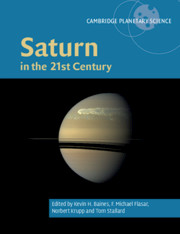Book contents
- Saturn in the 21st Century
- Cambridge Planetary Science
- Saturn in the 21st Century
- Copyright page
- Contents
- Contributors
- Reviewers
- 1 Introduction to Saturn in the 21st Century
- 2 The Origin and Evolution of Saturn, with Exoplanet Perspective
- 3 The Interior of Saturn
- 4 Saturn’s Magnetic Field and Dynamo
- 5 The Mysterious Periodicities of Saturn
- 6 Global Configuration and Seasonal Variations of Saturn’s Magnetosphere
- 7 Saturn’s Aurorae
- 8 Saturn’s Ionosphere
- 9 Saturn’s Variable Thermosphere
- 10 Saturn’s Seasonally Changing Atmosphere
- 11 The Global Atmospheric Circulation of Saturn
- 12 Saturn’s Polar Atmosphere
- 13 The Great Saturn Storm of 2010–2011
- 14 The Future Exploration of Saturn
- Index
- References
7 - Saturn’s Aurorae
Published online by Cambridge University Press: 13 December 2018
- Saturn in the 21st Century
- Cambridge Planetary Science
- Saturn in the 21st Century
- Copyright page
- Contents
- Contributors
- Reviewers
- 1 Introduction to Saturn in the 21st Century
- 2 The Origin and Evolution of Saturn, with Exoplanet Perspective
- 3 The Interior of Saturn
- 4 Saturn’s Magnetic Field and Dynamo
- 5 The Mysterious Periodicities of Saturn
- 6 Global Configuration and Seasonal Variations of Saturn’s Magnetosphere
- 7 Saturn’s Aurorae
- 8 Saturn’s Ionosphere
- 9 Saturn’s Variable Thermosphere
- 10 Saturn’s Seasonally Changing Atmosphere
- 11 The Global Atmospheric Circulation of Saturn
- 12 Saturn’s Polar Atmosphere
- 13 The Great Saturn Storm of 2010–2011
- 14 The Future Exploration of Saturn
- Index
- References
Summary
The aurorae of each planet are produced as a direct interaction between the upper atmosphere and magnetosphere of that planet. Energetic particles from the magnetosphere are driven into the top of the atmosphere, depositing energy there, and ultimately resulting in an electromagnetic emission. As a result, aurorae are related to conditions within the planetary magnetospheres so an understanding of the auroral emission provides a view of both the magnetospheric structure and how that magnetosphere is coupled with the underlying ionosphere. In the past, Saturn’s magnetosphere, and thus its aurorae, have been seen as something of a hybrid between the solar-wind-driven interaction at Earth and the rotationally dominated system at Jupiter. However, observations across a wide wavelength range by both the Cassini spacecraft and supporting Earth-based telescopes have revealed Saturn’s aurorae to be highly complex. We now recognize that Saturn’s aurorae are driven by the dynamic magnetic field interactions between the atmosphere, the solar wind and plasma trapped within the magnetosphere, all strongly affected by the rapid rotation of the planet.
In this chapter, we highlight the broad variety of auroral features observed at Saturn, and discuss how these are generated by energetic particles moving within current systems that link to solar wind interactions (Section 7.2), interactions with plasma generated within the magnetosphere (Section 7.3) and with current systems that vary periodically, including those linked to weather systems within Saturn’s upper atmosphere (Section 7.4). Finally, we conclude with a discussion of the major questions that remain about Saturn’s aurorae, and summarize the upcoming observations that will help us answer them. We begin with a discussion of how the auroral emission is generated and the characteristics of aurorae observed at Saturn. In particular, we highlight the most recent auroral research, following on from the overview of Saturn’s auroral processes presented in past reviews of the subject (for example, Kurth et al. 2009).
- Type
- Chapter
- Information
- Saturn in the 21st Century , pp. 166 - 195Publisher: Cambridge University PressPrint publication year: 2018
References
- 1
- Cited by



